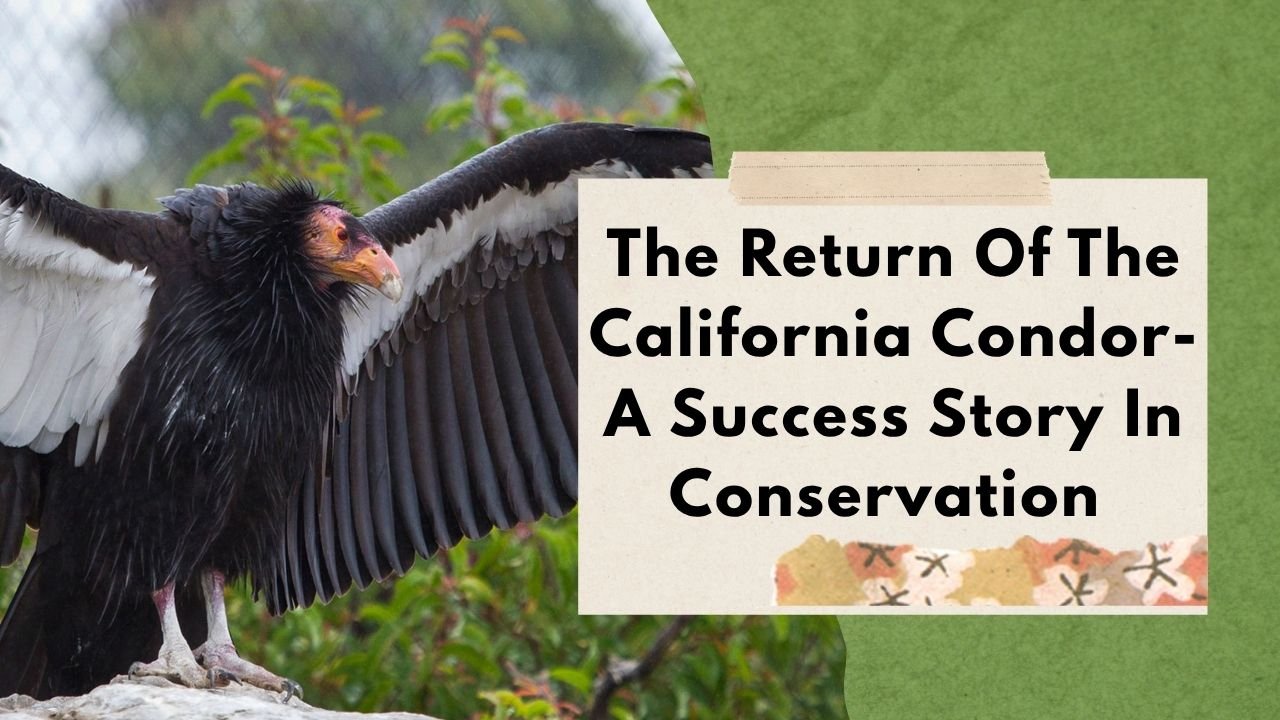From edge of extinction to soaring renewal — the California condor (Gymnogyps californianus) is writing one of the great recovery stories in wildlife conservation.
This majestic scavenger, once reduced to just 22 individuals in the wild, now thrives again thanks to bipartisan support, dedicated biologists, tribal leadership, and ordinary citizens choosing non-lead alternatives.
Why the condor nearly disappeared
At one point, condors soared from Baja California to British Columbia, but they declined catastrophically. The main drivers:
- Lead poisoning from eating carcasses with fragments from lead bullets
- Collisions with powerlines
- Habitat loss and fragmentation
- Illegal shooting and poaching
- Low reproductive rates, meaning recovery would be slow
To halt the decline, wildlife agencies captured the last surviving wild condors in the 1980s to start a captive breeding program. The goal: release healthy offspring, re-establish wild populations, and eventually reach a self-sustaining wild state.
Latest numbers (2024 & 2025 developments)
Here is the most up-to-date picture of where things stand:
| Metric | Latest Count / Update | Significance |
|---|---|---|
| Global condor population | ~ 566 individuals | Record high, surpassing many past years |
| Wild (free-flying) condors | ~ 369 | More are living wholly in the wild than ever before |
| Captive condors | ~ 197 | The breeding “bank” that produces release birds |
| Wild-fledged chicks in 2024 | 16 | Indicates that wild breeding is contributing to growth |
| Condors released in 2024 | 56 total (state and regional releases) | Largest single-year push in years |
| Lead-caused deaths (1992–2024) | ~ 151 cases | Lead remains the top documented killer |
| HPAI (avian flu) deaths in 2023–2024 | 21 condors (in the Arizona/Utah region) | Disease threat is real and intervention has begun |
| 2025 recent releases | 5 condors released near Grand Canyon (October 2025) | Southwest population rebuilding |
| Northern California (Yurok program) | 20+ free-flying condors by mid-2025 | Tribal restoration efforts gaining ground |
These numbers reflect a species still heavily managed but steadily gaining ground.
Tribal leadership & restoration in northern California
One of the most inspiring stories is the Yurok Tribe’s restoration initiative. After decades without condors in their ancestral skies, the tribe launched a collaborative Northern California Condor Restoration Program in partnership with federal and state agencies.
Releases began around 2022, and by 2025 the flock has steadily grown, venturing across Redwood and coastal forests in former condor habitat.
This model combines traditional ecological knowledge with modern wildlife biology, fostering deeper community engagement and long-term local stewardship. The presence of condors now is not just biological—it’s cultural and spiritual.
Key challenges and how they are tackled
1. Lead poisoning
This is the single greatest threat to condors. Tiny fragments from lead ammunition persist in animal carcasses, and scavenging condors ingest them unknowingly. Many die from acute poisoning unless treated.
Mitigation efforts include:
- Banning lead ammunition in condor zones (several states have adopted such bans)
- Educational campaigns for hunters to switch to non-lead alternatives
- Routine capture and blood testing of condors to detect elevated lead levels
- Chelation therapy for poisoned individuals when caught early
2. Disease (HPAI / Avian Influenza)
In recent years, a strain of highly pathogenic avian influenza struck the condor flock in Arizona and Utah, killing 21 birds. Agencies responded by vaccinating condors in parts of the range, intensifying surveillance, and isolating disease outbreaks. Fortunately, California flocks have thus far remained unaffected.
3. Wildfires & habitat risk
Large wildfires pose a catastrophic threat—one wildfire event killed 11 condors in one go and destroyed sanctuaries and infrastructure. To counter that:
- Release sites are diversified (coastal, inland, northern range)
- Contingency plans relocate condors preemptively during fire seasons
- Habitats with lower fire risk are prioritized for new releases
4. Genetic health & breeding
Though the breeding program has made remarkable gains, condors have very limited genetic diversity. Managing pairings carefully, avoiding inbreeding, and maintaining robust captive breeding protocols are essential.
Breeding success and the pipeline of new birds
Captive institutions have broken breeding records. In 2024, one zoological center achieved a record hatching of 17 condor chicks. These chicks are carefully raised to minimize human imprinting so they can adapt well when released into the wild.
As of 2024, there were about 50 chicks slated for 2025 release, feeding into restoration programs across the West and Northern California. These youngsters are the lifeblood of the comeback.
Where and how to see wild condors
If you want to witness condors in flight, these locations are the best bets:
- Big Sur & San Simeon coastlines
- Pinnacles National Park (nesting stronghold)
- Bitter Creek / Sespe in Southern California
- Grand Canyon / Vermilion Cliffs (Southwest flock)
- Baja California
- Redwood National & State Parks (Yurok territory)
Many wildlife groups host viewing programs. Always respect buffer zones and do not approach carcasses or feeding birds.
What must happen next for long-term recovery
To transform this comeback into a sustainable, self-maintaining population, these steps are critical:
- Expanded bans & incentives for non-lead ammunition, both inside and outside designated condor zones
- Continued field monitoring, trapping, testing, and treatment, especially during high-risk periods
- Strengthened disease defenses, including vaccine rollout and early detection programs
- Habitat protection and restoration, ensuring safe flight corridors and foraging grounds
- Community and Indigenous engagement, building local stewardship and support
- Funding stability to maintain both captive and wild programs over decades
With those in place, the condor’s future becomes more stable and less dependent on intensive human assistance.
The resurgence of the California condor is one of the most inspiring stories in conservation. From the darkest days of only 22 wild birds to now over 560 total, and nearly 370 flying free, the path forward is promising—yet still fraught with peril.
Lead poisoning, disease, and wildfire remain potent threats. But with coordinated efforts in ammunition reform, disease control, tribal leadership, habitat protection, and community engagement, the condor’s wings are strong once more.
The shadow above is spreading again—and may someday soar unassisted across the American West.
FAQs
Are California condors still classified as endangered?
Yes. Even with over 500 individuals in total, condors rely heavily on human intervention: lead mitigation, disease monitoring, habitat management, and release programs. They are not yet self-sufficient in the wild.
How exactly does lead poisoning kill condors?
When someone shoots an animal with lead ammunition, micro-fragments scatter into tissue. A condor feeding on that carcass ingests small particles, which accumulate in its bloodstream and damage the nervous system, kidneys, and other organs. Without rapid treatment, the poisoning is often lethal.
Can condors return to places like Northern California or Oregon?
Yes — that is central to many restoration plans. The success of the Yurok Tribe’s program in northern California demonstrates that condors can reoccupy former ranges. Future expansions may include Oregon and other parts of the Pacific Northwest, provided safe habitat, food sources, and protective measures are in place.


